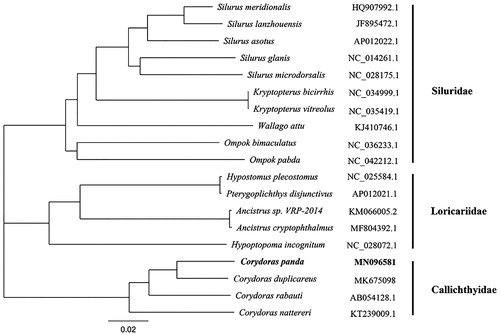Abstract
We reported the complete mitochondrial genome yielded by next-generation sequencing of Corydoras panda in this study. The total length of the mitochondrial genome is 16,611 bp, with the base composition of 32.50% A, 26.30% T, 26.10% C, and 15.10% G, respectively. It contains two ribosomal RNA genes, 13 protein-coding genes, 22 transfer RNA genes, and a major non-coding control region (D-loop region). The arrangement of these genes is the same as that found in the Siluriformes. The complete mitogenomes of C. panda and other 18 species from Siluriformes were used for phylogenetic analysis using Neighbor-Joining method. The topology demonstrated that all species belong to nine genera are divided into three groups (Siluridae, Loricariidae, and Callichthyidae), and the C. panda was clustered with other species from genus Corydoras. Corydoras panda external morphological feature classification is consistent with the molecular classification results, so the information of the mitogenome could be used for future identification of Corydoras species.
Corydoras panda, belongs to Teleostei, Siluriformes, Callichthyidae, Corydoradinae, Corydoras, is usually named ‘panda mouse’ in Chinese ornamental fish market because of the external morphological feature of a light colored body with black blob covering their eyes (like the panda), a black spot the dorsal fin, and a spot on or near the base of the caudal fin.
We determined the mitochondrial genome sequence of the ‘panda mouse’ C. panda in order to distinguish and identify the species more accurately and carried out mitochondrial genome structure and phylogenetic analysis. The living body of ‘panda mouse’ was collected from the Red Star Ornamental Fish Market in Changsha, Hunan Province, China (113.03 E, 28.09 N). After anesthesia with MS-222 (3-Aminobenzoic acid ethyl ester methanesulfonate), dorsal muscle tissue was collected and preserved in 99% ethanol in Museum of Hunan Agricultural University. After DNA extraction (Tissue DNA Kit D3396-02, Omega, bio-tek) and sequencing library construction(Sangon Biotech, Shanghai), paired-end reads were sequenced using HiSeq XTen PE 150 of Illumina. BBduk and BLAST + were used to assess and monitor data quality. NOVOPlasty and SPAdes were used for de novo assembly. MITOS2 server and Geneious R11 (Liu et al. Citation2019; Tan et al. Citation2019) were used to predict and annotate the mitochondrial genome. Geneious Tree Builder was used for phylogenetic analysis and building phylogenetic tree.
Totally 23,481,486 high-quality clean reads (150 bp PE read length) were obtained. The total length of the C. panda mitochondrial genome is 16,611 bp (GenBank accession number: MN096581), with the base composition of 32.50% A, 26.30% T, 26.10% C, and 15.10% G, respectively. It contains two ribosomal RNA genes, 13 protein-coding genes, 22 transfer RNA genes, and a major non-coding control region 994 bp in length (D-loop region). The arrangement of these genes is the same as that found in the Siluriformes (Saitoh et al. Citation2003; Liu et al. Citation2019). All the protein initiation codons are ATG, except for cox1 that begins with GTG. The complete mitogenomes of C. panda and other 18 species from Siluriformes were used for phylogenetic analysis. The Neighbor-Joining tree builded by Geneious with Tamura–Nei (genetic distance model) and global aligment with free end gaps (aligment type) showed all species belong to 9 genera are divided into three groups (Siluridae, Loricariidae and Callichthyidae), and the C. panda was clustered with other species from genus Corydoras (). Corydoras panda external morphological feature classification is consistent with the molecular classification results, so the information of the mitogenome could be used for future phylogenetic analysis and identification of Corydoras species (Betancur et al. Citation2017).
Disclosure statement
No potential conflict of interest was reported by the authors.
Additional information
Funding
References
- Betancur RR, Wiley EO, Arratia G, Acero A, Bailly N, Miya M, Lecointre G, Ortí G. 2017. Phylogenetic classification of bony fishes. BMC Evol Biol. 17:162.
- Tan J, Yin Z, Huang H, Zeng C. 2019. Characterization and phylogenetic analysis of Acheilognathus chankaensis mitochondrial genome. Mitochondrial DNA B. 4:1148–1149.
- Liu Q, Xu B, Xiao T. 2019. Complete mitochondrial genome of Corydoras duplicareus (Teleostei, Siluriformes, Callichthyidae). Mitochondrial DNA B. 4:1832–1833.
- Saitoh K, Miya M, Inoue JG, Ishiguro NB, Nishida M. 2003. Mitochondrial genomics of ostariophysan fishes: perspectives on phylogeny and biogeography. J Mol Evol. 56:464–472.

